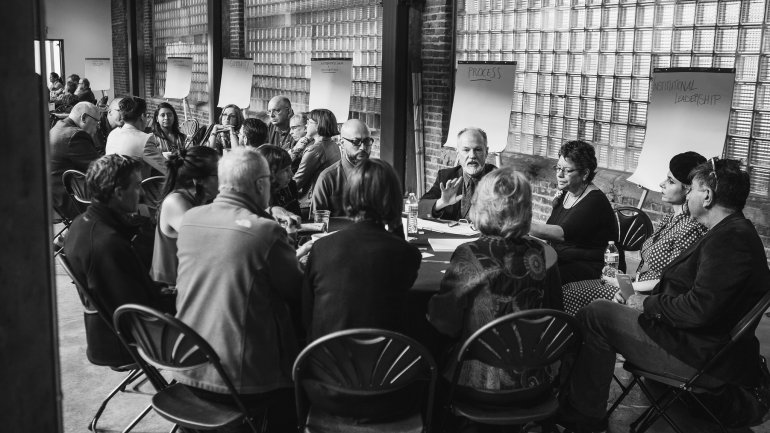A Peek Behind the Director’s Curtain
From American Craft Inquiry: Volume 1, Issue 1
Most executive directors of craft organizations conduct their work behind the scenes, directing attention to artists, their artworks, and audiences. They style themselves after the Wizard of Oz, with “Pay no attention to the man behind the curtain” as their watchwords. They perform many of their duties in a public arena and they combine their personal goals for their institutions with those of a variety of audiences to further the organization’s mission.
The “Present Tense” conference provided an opportunity for three of us – Fabio Fernández, executive director of the Society of Arts and Crafts in Boston, Jean McLaughlin, executive director of the Penland School of Crafts in North Carolina, and me – to pull back the curtain and explore the institutional and private sides of our roles.
Contemporary artists have been encouraged to express their individuality through their artwork. They make the personal public in each piece they create. But while directors are as passionate as artists are about our personal visions, we must present our ideas in a more controlled way – one that fits the size and capabilities of our institutions. In the conference’s leadership session, I wanted to address the outward aspects of the panelists’ roles, as well as the personal side that all administrators bring to their positions.
Before the conference, I shared with Fernández and McLaughlin a series of 17 questions that were evenly divided between our role as directors and our institution. Their feedback resulted in the selection of five questions covering the communal aspects of our administrative roles and the private nature of our positions. The personal aspect was important to incorporate, because directors can become so closely associated with their institutions that their private lives are overlooked; the institution and the professional behind the curtain become one.
We started by addressing the image of power and control that people automatically associate with directors’ roles – as opposed to how these jobs really function. How much influence does an executive have over how his or her institution carries out its mission? We spoke about this leadership position being more about shared responsibility than individual power. The board of directors oversees the organization, and the executive works for and with the board to establish a common vision. The executive leads staff members in following this vision, but at the same time must empower them and trust them to perform. The director identifies people’s skills and helps volunteers and staff play to their strengths on behalf of the organization.
Coordinating the efforts of volunteers and employees can be challenging and time-consuming. The executive functions as part cheerleader, part ringmaster – and also as the public face of the institution. Many directors begin their careers in departments or positions where they can concentrate on a focused aspect of an institution. In a leadership role, one must step back and focus on the entire organization – not one or two of its facets.
Our institutions serve multiple communities – a plurality of audiences – that must each be brought into and made a part of the mission. Students, visitors, and donors must all be nurtured, and artists must be recognized as key stakeholders who should be represented on boards and staffs.
In our field, we directors believe craft is good for celebrating and building communities. We have strong networks and a great deal of sharing among our artists – a generosity of spirit, combined with a degree of fearlessness. Craft tends to be non-elitist and open-minded, and its institutions tend to be nimble in responding to the field’s needs. At the same time, we are apt to burn through executive directors and trustees too quickly. Funders are not as open to craft as they are to other sectors of the visual arts, and the world of philanthropy needs to be more supportive. Corporations and governments in communities where we live and work need to be inspired to help.
As to the more personal side of our positions, we spoke about balancing our own creative pursuits, such as making art and writing, with the responsibilities on our desks. For the most part, we believe this trade-off is fair and the work is rewarding. Each day is different, and on all of them, both good and bad things happen. A good day is when a staff member benefits from participating in one of the programs you offer, a visitor has a true moment of understanding with a work of art, or an artist whose work you have championed receives a major award. The tough days frequently occur around financial reports to our board and external problems and incidents beyond our control that affect our institutions. You can never plan for these kinds of things, and they must be solved by us – usually soon after they occur.
We asked where new directors will come from, given that our jobs can be perceived as challenging. Curators, given their experiences with objects and budgets, are often well prepared for directorships. At the same time, some craft organizations have had great success hiring directors from the nonprofit sector with no art-world experience. Taking a page from craft’s history of apprenticeships with masters, mentors can encourage a range of professionals to seek these roles and to they can help candidates transition from different disciplines.
I was honored to host this conversation with two colleagues I respect. They were open and generous in the ways they shared their thoughts about our contributions to and hopes for our field. I hope this session adds further clarity to these complicated and rewarding roles and invites others to follow us behind the curtain on this career path.
Read more from the first issue purchase issue

